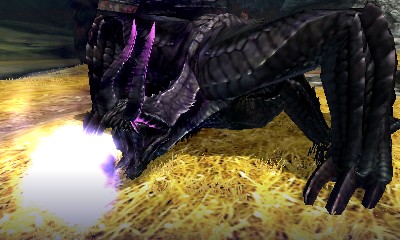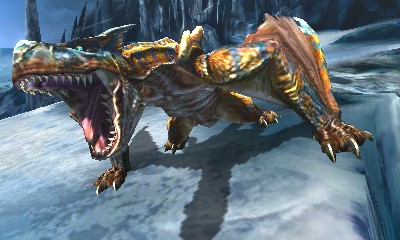Publisher: Capcom
Developer: Capcom
Medium: Digital
Players: 1-4
Online: Yes
ESRB: T
While a lot of New 3DS owners will likely be driving home with a copy of The Legend of Zelda: Majora?s Mask 3D to accompany their brand new system, I sincerely hope people don?t sleep on the newest installment of Capcom?s Monster Hunter series. While there?s not a lot in the way of massive changes to the core structure of the series, Monster Hunter 4 Ultimate brings additional refinements, along with new weapon types, monsters, armor sets, and new areas to explore. This entry builds upon the groundwork laid out by the successful previous installment, while remaining addictive, fun, and remarkably exciting.
If you?ve never played a Monster Hunter title before, the core concept is deceptively simple. Your starting hunter picks from a variety of weapons, including Long Swords, Switch Axes, Lances, and Bows, along with other more eclectic options. You?ll take on quests that drop your hunter into an area segmented into sections, with most quests centering around a large monster you?ll need to defeat or capture. Think of it as Boss Fight: The Game, even though it?s a lot more nuanced than just titanic battles against dragons and other beasts.
 These monsters put up one hell of a fight, enough so that if you come into battle unprepared, you can expect to have your ass handed to you quickly. But learning the moves of various monsters, along with their strengths and weaknesses, is a huge part of the game. And learning how to quickly subdue an enemy that gave you tons of trouble just a few hours earlier is an incredibly gratifying experience. One of the series strengths is seeing how much you?re able to set your own path of progression, and how quickly and clearly you can see your abilities improve as a hunter.
These monsters put up one hell of a fight, enough so that if you come into battle unprepared, you can expect to have your ass handed to you quickly. But learning the moves of various monsters, along with their strengths and weaknesses, is a huge part of the game. And learning how to quickly subdue an enemy that gave you tons of trouble just a few hours earlier is an incredibly gratifying experience. One of the series strengths is seeing how much you?re able to set your own path of progression, and how quickly and clearly you can see your abilities improve as a hunter.
Another major aspect, and for some the most important, is the co-op experience. Monster Hunter 4 Ultimate finally brings an online mode to the 3DS, which works in a similar fashion to Monster Hunter 3 Ultimate on Wii U. You?ll meet up with other hunters via the Gathering Hall, which comes equipped with its own kitchen, item box, store, and Guild Quests, which remain separate from the single-player quests you can tackle. My experience with the online side was limited for the most part, but I?d expect this to work pretty well. Local co-op is still king, because communicating is certainly a key to success in later G-Rank battles, but online co-op should get the job done provided players understand their specific roles in a fight.
 Two new weapons are introduced to the Monster Hunter arsenal with this entry, the Insect Glaive and the Charge Blade. Both are pretty unique in direct comparison to the other weapons available. I personally found myself using the Insect Glaive almost exclusively, but both are solid additions here. The Charge Blade doubles as a sword/shield style weapon, providing limited offense with solid defense. But each strike landed can build up a charge on the blade, which can then be unleashed when you morph the weapon into a much larger blade, losing the defensive aspect of the weapon.
Two new weapons are introduced to the Monster Hunter arsenal with this entry, the Insect Glaive and the Charge Blade. Both are pretty unique in direct comparison to the other weapons available. I personally found myself using the Insect Glaive almost exclusively, but both are solid additions here. The Charge Blade doubles as a sword/shield style weapon, providing limited offense with solid defense. But each strike landed can build up a charge on the blade, which can then be unleashed when you morph the weapon into a much larger blade, losing the defensive aspect of the weapon.
The Insect Glaive is one part staff, one part flying bug. The bug attaches to your hunter and lies dormant until you send it out to harvest fluid from nearby monsters. Depending on the color of fluid harvested, you?ll be able to self-buff your hunter, increasing damage and speed. Ideally you?ll accumulate multiple buffs, making yourself more powerful for a limited range of time. One of the more interesting aspects of the Insect Glaive is the ability to launch yourself in the air via a pole-vault style move, useful for another interesting addition to the Monster Hunter formula introduced here.
 In Monster Hunter 4 Ultimate, you?re now able to mount large monsters and hack away at them with small knives, provided you can stay on while they thrash about and roar. When you successfully jump on the back of a monster, a meter at the bottom of the screen will show. You can begin to fill this meter by mashing the attack button, and if you fill it, you?ll knock the monster off its feet for a limited amount of time. To balance this out, you can?t mount a monster over and over again, there?s typically a waiting period in between. And each successive mount tends to be less effective.
In Monster Hunter 4 Ultimate, you?re now able to mount large monsters and hack away at them with small knives, provided you can stay on while they thrash about and roar. When you successfully jump on the back of a monster, a meter at the bottom of the screen will show. You can begin to fill this meter by mashing the attack button, and if you fill it, you?ll knock the monster off its feet for a limited amount of time. To balance this out, you can?t mount a monster over and over again, there?s typically a waiting period in between. And each successive mount tends to be less effective.
For players that don?t roll with the Insect Glaive, you?ll notice that verticality is a big part of Monster Hunter 4 Ultimate, almost entirely due to this mounting mechanic. Multiple areas will have walls to climb, and while attached to a wall, you can leap off to perform a mounting attack. This is a bit tougher to line-up than just using the Glaive, but is no less effective. This focus on verticality has replaced the water/swimming element of Monster Hunter 3 Ultimate, which in my mind was definitely a smart move to make. Having an added reason to climb and leap off of walls to attack helps make your hunter feel more mobile, and more effective regardless of the environment you might find yourself in.
Another feature that plays somewhat heavily into the single-player experience is the use of Palicoes, cat-like creatures that act as A.I. controlled partners you can take out in the field. Monster Hunter fans will already be familiar with these creatures, typically dubbed Felynes, and found in other Monster Hunter titles. But their role is expanded on a bit here, with a village area that opens up early on, which allows you to use your Palicoes to fish, and even go on independent adventures to find materials used to craft their very own armor.
 The only real complaint I have against Monster Hunter 4 Ultimate is that inventory management, specifically when it comes to equipment, is still remarkably clunky. A big part of the game is harvesting materials from defeated monsters to build new armor and weapons. You do this because armor sets from different monsters typically provide bonuses, like the ability to negate poison, enhanced health, stronger attacks, and so on.
The only real complaint I have against Monster Hunter 4 Ultimate is that inventory management, specifically when it comes to equipment, is still remarkably clunky. A big part of the game is harvesting materials from defeated monsters to build new armor and weapons. You do this because armor sets from different monsters typically provide bonuses, like the ability to negate poison, enhanced health, stronger attacks, and so on.
But once you get to the point that you?re tackling 5 and 6 star quests, you?re starting to swim in various pieces of armor and you?ll likely have multiple weapons. You can don a set of armor and assign that set to a shortcut, but the inventory system could really use a filter option to help you track down pieces with certain stats and bonuses attached. This is doubly true when it comes to navigating the Blacksmith menu, where I?d at least like an option that allows me to filter out the armor pieces I already have.
That said, it?s a relatively minor complaint compared to how high-quality the rest of Monster Hunter 4 Ultimate tends to be. It?s an incredibly fun, challenging, and downright rewarding experience. The camera controls mapped to the touchscreen take some adjusting to, but the ability to soft-lock larger monsters takes away much of the frustration, and the New 3DS nub should solve that issue entirely. Monster Hunter 4 Ultimate is also surprisingly pretty on the 3DS, at least when it comes to character and monster models. I was also happy to see that load times are kept to a minimum, along with any notable technical issues. Overall the game sports a level of polish that?s unfortunately not present in a lot of games nowadays.
So again, I?d highly urge you to check out Monster Hunter 4 Ultimate when it releases on February 13th. It?s easily the best Monster Hunter title to date, and well worth picking up both for Monster Hunter vets and newcomers. If you?re looking for a fun, portable, co-op and single player experience packed with content, look no further than Monster Hunter 4 Ultimate.

